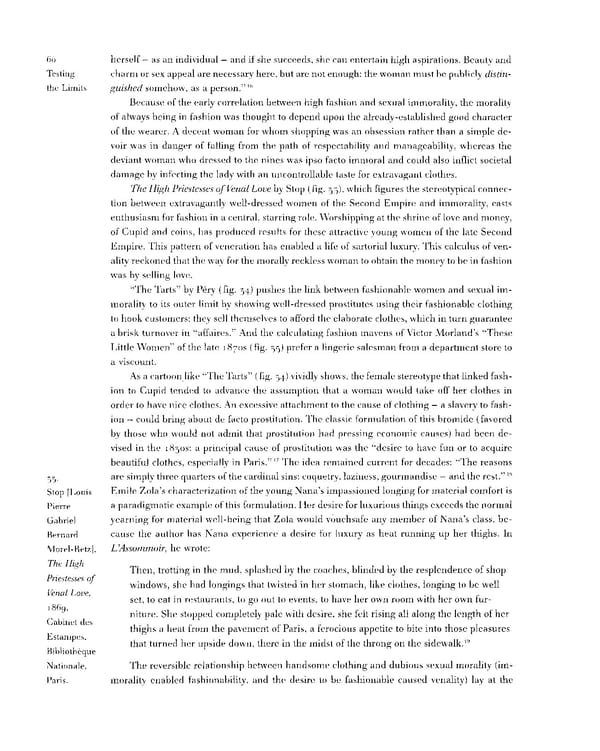6o herself — as an individual — and if she succeeds, she can entertain high aspirations. Beauty and Testing charm or sex appeal are necessary here, but are not enough: the woman must be publicly distin- the Limits guished somehow, as a person." 16 Because of the early correlation between high fashion and sexual immorality, the morality of always being in fashion was thought to depend upon the already-established good character of the wearer. A decent woman for whom shopping was an obsession rather than a simple de- voir was in danger of falling from the path of respectability and manageability, whereas the deviant woman who dressed to the nines was ipso facto immoral and could also inflict societal damage by infecting the lady with an uncontrollable taste for extravagant clothes. The High Priestesses of Venal Love by Stop (fig. 33), which figures the stereotypical connec- tion between extravagantly well-dressed women of the Second Empire and immorality, casts enthusiasm for fashion in a central, starring role. Worshipping at the shrine of love and money, of Cupid and coins, has produced results for these attractive young women of the late Second Empire. This pattern of veneration has enabled a life of sartorial luxury. This calculus of ven- ality reckoned that the way for the morally reckless woman to obtain the money to be in fashion was by selling love. "The Tarts" by Pery (fig. 34) pushes the link between fashionable women and sexual im- morality to its outer limit by showing well-dressed prostitutes using their fashionable clothing to hook customers: they sell themselves to afford the elaborate clothes, which in turn guarantee a brisk turnover in "affaires." And the calculating fashion mavens of Victor Morland's "These Little Women" of the late 18705 (fig. 35) prefer a lingerie salesman from a department store to a viscount. As a cartoon like "The Tarts" (fig. 34) vividly shows, the female stereotype that linked fash- ion to Cupid tended to advance the assumption that a woman would take off her clothes in order to have nice clothes. An excessive attachment to the cause of clothing — a slavery to fash- ion — could bring about de facto prostitution. The classic formulation of this bromide (favored by those who would not admit that prostitution had pressing economic causes) had been de- vised in the 18308: a principal cause of prostitution was the "desire to have fun or to acquire 17 beautiful clothes, especially in Paris." The idea remained current for decades: "The reasons 18 35- are simply three quarters of the cardinal sins: coquetry, laziness, gourmandise — and the rest." Stop [Louis Emile Zola's characterization of the young Nana's impassioned longing for material comfort is Pierre a paradigmatic example of this formulation. Her desire for luxurious things exceeds the normal Gabriel yearning for material well-being that Zola would vouchsafe any member of Nana's class, be- Bernard cause the author has Nana experience a desire for luxury as heat running up her thighs. In Morel-Retz], UAssommoir, he wrote: The High Then, trotting in the mud, splashed by the coaches, blinded by the resplendence of shop Priestesses of windows, she had longings that twisted in her stomach, like clothes, longing to be well Venal Love, set, to eat in restaurants, to go out to events, to have her own room with her own fur- 1869, niture. She stopped completely pale with desire, she felt rising all along the length of her Cabinet des thighs a heat from the pavement of Paris, a ferocious appetite to bite into those pleasures Estampes, 19 Bibliotheque that turned her upside down, there in the midst of the throng on the sidewalk. Nationale, The reversible relationship between handsome clothing and dubious sexual morality (im- Paris. morality enabled fashionability, and the desire to be fashionable caused venality) lay at the
 Prostitution & Impressionists Page 80 Page 82
Prostitution & Impressionists Page 80 Page 82